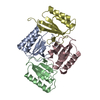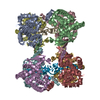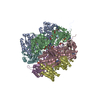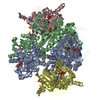+ Open data
Open data
- Basic information
Basic information
| Entry | Database: EMDB / ID: EMD-5672 | |||||||||
|---|---|---|---|---|---|---|---|---|---|---|
| Title | CryoEM Structure of the KaiBC Complex | |||||||||
 Map data Map data | Reconstruction of KaiB-KaiC(489 deletion) | |||||||||
 Sample Sample |
| |||||||||
 Keywords Keywords |  Circadian oscillator / Circadian oscillator /  cryoEM / MDFF / protein-protein interface / cryoEM / MDFF / protein-protein interface /  Synechococcus elongatus Synechococcus elongatus | |||||||||
| Function / homology |  Function and homology information Function and homology information : / : /  : / regulation of phosphorelay signal transduction system / negative regulation of circadian rhythm / entrainment of circadian clock / negative regulation of phosphorylation / protein serine/threonine/tyrosine kinase activity / : / regulation of phosphorelay signal transduction system / negative regulation of circadian rhythm / entrainment of circadian clock / negative regulation of phosphorylation / protein serine/threonine/tyrosine kinase activity /  Hydrolases; Acting on acid anhydrides; Acting on acid anhydrides to facilitate cellular and subcellular movement / Hydrolases; Acting on acid anhydrides; Acting on acid anhydrides to facilitate cellular and subcellular movement /  regulation of circadian rhythm / regulation of circadian rhythm /  circadian rhythm ... circadian rhythm ... : / : /  : / regulation of phosphorelay signal transduction system / negative regulation of circadian rhythm / entrainment of circadian clock / negative regulation of phosphorylation / protein serine/threonine/tyrosine kinase activity / : / regulation of phosphorelay signal transduction system / negative regulation of circadian rhythm / entrainment of circadian clock / negative regulation of phosphorylation / protein serine/threonine/tyrosine kinase activity /  Hydrolases; Acting on acid anhydrides; Acting on acid anhydrides to facilitate cellular and subcellular movement / Hydrolases; Acting on acid anhydrides; Acting on acid anhydrides to facilitate cellular and subcellular movement /  regulation of circadian rhythm / regulation of circadian rhythm /  circadian rhythm / circadian rhythm /  non-specific serine/threonine protein kinase / non-specific serine/threonine protein kinase /  phosphorylation / protein serine kinase activity / protein serine/threonine kinase activity / regulation of DNA-templated transcription / magnesium ion binding / phosphorylation / protein serine kinase activity / protein serine/threonine kinase activity / regulation of DNA-templated transcription / magnesium ion binding /  ATP hydrolysis activity / ATP hydrolysis activity /  DNA binding / DNA binding /  ATP binding / identical protein binding / ATP binding / identical protein binding /  plasma membrane / plasma membrane /  cytoplasm cytoplasmSimilarity search - Function | |||||||||
| Biological species |   Synechococcus elongatus (bacteria) Synechococcus elongatus (bacteria) | |||||||||
| Method |  single particle reconstruction / single particle reconstruction /  cryo EM / Resolution: 16.0 Å cryo EM / Resolution: 16.0 Å | |||||||||
 Authors Authors | Villarreal SA / Pattanayek R / Williams DR / Mori T / Qin X / Johnson CH / Egli M / Stewart PL | |||||||||
 Citation Citation |  Journal: J Mol Biol / Year: 2013 Journal: J Mol Biol / Year: 2013Title: CryoEM and molecular dynamics of the circadian KaiB-KaiC complex indicates that KaiB monomers interact with KaiC and block ATP binding clefts. Authors: Seth A Villarreal / Rekha Pattanayek / Dewight R Williams / Tetsuya Mori / Ximing Qin / Carl H Johnson / Martin Egli / Phoebe L Stewart /  Abstract: The circadian control of cellular processes in cyanobacteria is regulated by a posttranslational oscillator formed by three Kai proteins. During the oscillator cycle, KaiA serves to promote ...The circadian control of cellular processes in cyanobacteria is regulated by a posttranslational oscillator formed by three Kai proteins. During the oscillator cycle, KaiA serves to promote autophosphorylation of KaiC while KaiB counteracts this effect. Here, we present a crystallographic structure of the wild-type Synechococcus elongatus KaiB and a cryo-electron microscopy (cryoEM) structure of a KaiBC complex. The crystal structure shows the expected dimer core structure and significant conformational variations of the KaiB C-terminal region, which is functionally important in maintaining rhythmicity. The KaiBC sample was formed with a C-terminally truncated form of KaiC, KaiC-Δ489, which is persistently phosphorylated. The KaiB-KaiC-Δ489 structure reveals that the KaiC hexamer can bind six monomers of KaiB, which form a continuous ring of density in the KaiBC complex. We performed cryoEM-guided molecular dynamics flexible fitting simulations with crystal structures of KaiB and KaiC to probe the KaiBC protein-protein interface. This analysis indicated a favorable binding mode for the KaiB monomer on the CII end of KaiC, involving two adjacent KaiC subunits and spanning an ATP binding cleft. A KaiC mutation, R468C, which has been shown to affect the affinity of KaiB for KaiC and lengthen the period in a bioluminescence rhythm assay, is found within the middle of the predicted KaiBC interface. The proposed KaiB binding mode blocks access to the ATP binding cleft in the CII ring of KaiC, which provides insight into how KaiB might influence the phosphorylation status of KaiC. | |||||||||
| History |
|
- Structure visualization
Structure visualization
| Movie |
 Movie viewer Movie viewer |
|---|---|
| Structure viewer | EM map:  SurfView SurfView Molmil Molmil Jmol/JSmol Jmol/JSmol |
| Supplemental images |
- Downloads & links
Downloads & links
-EMDB archive
| Map data |  emd_5672.map.gz emd_5672.map.gz | 1.5 MB |  EMDB map data format EMDB map data format | |
|---|---|---|---|---|
| Header (meta data) |  emd-5672-v30.xml emd-5672-v30.xml emd-5672.xml emd-5672.xml | 11.3 KB 11.3 KB | Display Display |  EMDB header EMDB header |
| Images |  emd_5672_1.tif emd_5672_1.tif | 163.7 KB | ||
| Archive directory |  http://ftp.pdbj.org/pub/emdb/structures/EMD-5672 http://ftp.pdbj.org/pub/emdb/structures/EMD-5672 ftp://ftp.pdbj.org/pub/emdb/structures/EMD-5672 ftp://ftp.pdbj.org/pub/emdb/structures/EMD-5672 | HTTPS FTP |
-Related structure data
- Links
Links
| EMDB pages |  EMDB (EBI/PDBe) / EMDB (EBI/PDBe) /  EMDataResource EMDataResource |
|---|---|
| Related items in Molecule of the Month |
- Map
Map
| File |  Download / File: emd_5672.map.gz / Format: CCP4 / Size: 1.9 MB / Type: IMAGE STORED AS FLOATING POINT NUMBER (4 BYTES) Download / File: emd_5672.map.gz / Format: CCP4 / Size: 1.9 MB / Type: IMAGE STORED AS FLOATING POINT NUMBER (4 BYTES) | ||||||||||||||||||||||||||||||||||||||||||||||||||||||||||||||||||||
|---|---|---|---|---|---|---|---|---|---|---|---|---|---|---|---|---|---|---|---|---|---|---|---|---|---|---|---|---|---|---|---|---|---|---|---|---|---|---|---|---|---|---|---|---|---|---|---|---|---|---|---|---|---|---|---|---|---|---|---|---|---|---|---|---|---|---|---|---|---|
| Annotation | Reconstruction of KaiB-KaiC(489 deletion) | ||||||||||||||||||||||||||||||||||||||||||||||||||||||||||||||||||||
| Voxel size | X=Y=Z: 2.32 Å | ||||||||||||||||||||||||||||||||||||||||||||||||||||||||||||||||||||
| Density |
| ||||||||||||||||||||||||||||||||||||||||||||||||||||||||||||||||||||
| Symmetry | Space group: 1 | ||||||||||||||||||||||||||||||||||||||||||||||||||||||||||||||||||||
| Details | EMDB XML:
CCP4 map header:
| ||||||||||||||||||||||||||||||||||||||||||||||||||||||||||||||||||||
-Supplemental data
- Sample components
Sample components
-Entire : KaiB in complex with KaiC(489del)
| Entire | Name: KaiB in complex with KaiC(489del) |
|---|---|
| Components |
|
-Supramolecule #1000: KaiB in complex with KaiC(489del)
| Supramolecule | Name: KaiB in complex with KaiC(489del) / type: sample / ID: 1000 Details: Visualization of the sample showed complexes of KaiBC and KaiC. Oligomeric state: One Hexamer of KaiC binds to 6 monomers of KaiB Number unique components: 2 |
|---|---|
| Molecular weight | Theoretical: 510 KDa |
-Macromolecule #1: KaiB
| Macromolecule | Name: KaiB / type: protein_or_peptide / ID: 1 / Name.synonym: Circadian clock protein KaiB / Number of copies: 6 / Oligomeric state: Dimer / Recombinant expression: Yes |
|---|---|
| Source (natural) | Organism:   Synechococcus elongatus (bacteria) / Strain: PCC 7942 / Location in cell: Cytoplasm Synechococcus elongatus (bacteria) / Strain: PCC 7942 / Location in cell: Cytoplasm |
| Molecular weight | Theoretical: 12 KDa |
| Recombinant expression | Organism:   Escherichia coli (E. coli) Escherichia coli (E. coli) |
| Sequence | UniProtKB: Circadian clock oscillator protein KaiB / GO: GO: 3773505 / InterPro:  Circadian clock protein KaiB Circadian clock protein KaiB |
-Macromolecule #2: KaiC
| Macromolecule | Name: KaiC / type: protein_or_peptide / ID: 2 / Name.synonym: Circadian clock protein kinase KaiC / Details: C terminal truncation of KaiC at 489 / Number of copies: 1 / Oligomeric state: Hexamer / Recombinant expression: Yes |
|---|---|
| Source (natural) | Organism:   Synechococcus elongatus (bacteria) / Strain: PCC 7942 / Location in cell: Cytoplasm Synechococcus elongatus (bacteria) / Strain: PCC 7942 / Location in cell: Cytoplasm |
| Molecular weight | Theoretical: 340 KDa |
| Recombinant expression | Organism:   Escherichia coli (E. coli) Escherichia coli (E. coli) |
| Sequence | UniProtKB: Circadian clock oscillator protein KaiC / GO: GO: 3773504 / InterPro: Circadian clock KaiC, bacteria |
-Experimental details
-Structure determination
| Method |  cryo EM cryo EM |
|---|---|
 Processing Processing |  single particle reconstruction single particle reconstruction |
| Aggregation state | particle |
- Sample preparation
Sample preparation
| Buffer | Details: 20 mM HEPES-NaOH, pH 8.0, 150 mM NaCl, 5 mM MgCl2, 0.5 mM EDTA |
|---|---|
| Grid | Details: homemade holey carbon film and C-flat grids (Protochips, Inc.) |
| Vitrification | Cryogen name: ETHANE / Chamber temperature: 184 K / Instrument: HOMEMADE PLUNGER |
- Electron microscopy
Electron microscopy
| Microscope | FEI POLARA 300 |
|---|---|
| Electron beam | Acceleration voltage: 300 kV / Electron source:  FIELD EMISSION GUN FIELD EMISSION GUN |
| Electron optics | Calibrated magnification: 254669 / Illumination mode: FLOOD BEAM / Imaging mode: BRIGHT FIELD Bright-field microscopy / Cs: 2.26 mm / Nominal defocus max: -5.0 µm / Nominal defocus min: -1.0 µm / Nominal magnification: 200000 Bright-field microscopy / Cs: 2.26 mm / Nominal defocus max: -5.0 µm / Nominal defocus min: -1.0 µm / Nominal magnification: 200000 |
| Sample stage | Specimen holder model: OTHER |
| Temperature | Min: 98 K / Max: 105 K / Average: 101 K |
| Date | Jun 2, 2010 |
| Image recording | Category: CCD / Film or detector model: GATAN ULTRASCAN 4000 (4k x 4k) / Number real images: 11734 / Bits/pixel: 16 |
| Experimental equipment |  Model: Tecnai Polara / Image courtesy: FEI Company |
- Image processing
Image processing
| CTF correction | Details: Each micrograph |
|---|---|
| Final two d classification | Number classes: 2000 |
| Final reconstruction | Algorithm: OTHER / Resolution.type: BY AUTHOR / Resolution: 16.0 Å / Resolution method: FSC 0.5 CUT-OFF Software - Name: FREALIGN, Rubinstein_2_Refinement_package, IMAGIC Details: Final map was calculated from 3 data sets. / Number images used: 195226 |
| Details | The particles were selected manually. |
 Movie
Movie Controller
Controller












